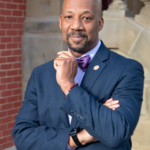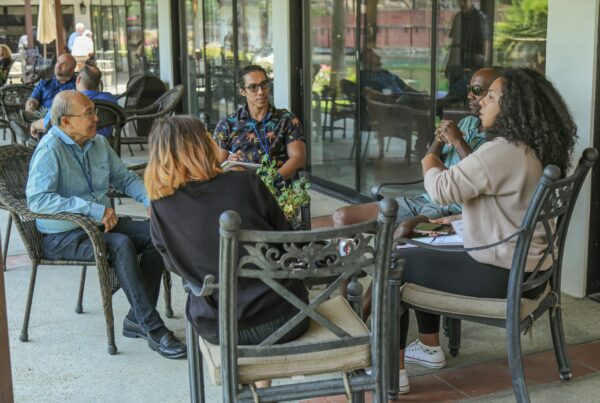In this excerpt from Trauma and Race: A Path to Wellbeing, Rev. Micah McCreary shares about a counseling session with a racially traumatized family that grew into a healing space. That experience—and advice from his supervisor—taught him the importance of being a healing presence and connecting with people seeking healing from racial trauma. This excerpt comes from chapter four, “Challenging Barriers,” found in the second part of the book, which focuses on healing and practice.
Y ears ago, my counseling supervisor, Dr. Carl Whitaker, forced me to use and respect my unconscious. While I was counseling a family of four, Whitaker was observing my session through a one-way mirror. He called me out of the session and said, “Young man, I don’t know who that counselor is in the room with that family. Trust your gut, man. Have that family appreciate and experience who they are by connecting with them and drawing them in.” Returning to the session, I shifted our focus to the dynamics of relationships. Encouraged by my conversation with my supervisor, I shared that I was a trauma survivor and the effect that trauma had on my life. Based on their knowing responses, I sensed that the family was “stuck” in dysfunction because they were deeply wounded. I began inquiring and holding conversations with the family around their prior relationships, with an openness to trauma and racially traumatic experiences. The very vocal and powerful mother mentioned that, as a child and a young woman, she was teased about her size and her dark complexion. She mentioned the abuse from her previous husband and the pain around her not being able to conceive a child with him. This mother informed her family that her first husband had blamed her for their marital problems and belittled her as a woman. Her daughter, who was adopted, shared that she understood because she had been abused while with a foster family. Her son got up from his seat and hugged his mother.
The father sat emotionally paralyzed during his wife’s and daughter’s tearful disclosures. Noticing his discomfort, I asked him to share with his family what he was experiencing. He then began to share the story of his first marriage. This father disclosed that previously he was married to a white woman he had met in the military. He stated that, at first, she loved him and they were very happy, but after the birth of their son, their relationship changed. His first wife became rageful and abusive to him and their son. Initially, she would just yell and shout, but gradually she began to slap and hit. He explained that her anger was connected to the African American features of his son and the rejection of their family by the wife’s family. The father further stated that he took the abuse until she hurt their son, which is when he and his son moved out. During this conversation the son just sat in the room with his chin in his hands and looked at his father. It was the first time he had heard the details of his and his father’s abuse. When his father began to cry, the son cautiously put his hand on his father’s knee.
As a result of our conversations, we named our counseling space as a healing space. We uncovered that the parents were struggling with feelings of inadequacy and vulnerability that were being manifested in the behavior of their children. The counseling focus switched from the scapegoated child to the dynamic dysfunction within the executive system—to the impact of racial trauma on the executive system and the sibling system. Our work together became a growing space around our traumas. I did not speak in depth about my traumas but used metaphors and spiritual analogies to ground their stories in hope, reconciliation, and healing. As I have revisited my time with this family over the years, I believe that I owe them tremendous gratitude for allowing me to walk with them into, through, and out of their racial trauma experiences.
Dr. Whitaker’s advice on being human and connecting with the family around their problem freed me to let my true self occupy the necessary healing place in a family system. My supervisor was instructing me to be a healing presence. Years of reflecting on his teaching and integrating his theories has equipped me to work with honesty and integrity when addressing issues of trauma and particularly racial trauma in my preaching, teaching, and clinical practice. When counseling racially traumatized clients, it is often helpful to combine psychological knowledge with one’s spiritual-cultural-experiential core beliefs. This stance encourages counselors to integrate into their therapy who they were, who they are, and who they are becoming.
Treating racially traumatized families requires an integrative counseling approach. The counselor must develop a comfort in the uncertainties and contradictions of clients’ lived experiences. What’s needed is a sensitivity and openness to all experiences of families and individuals brave enough to seek counseling.
Content from Trauma and Race: A Pathway to Wellbeing by Micah McCreary, ©2023. Used by permission of Fortress Press.
Disclaimer: Some of the links in this article are affiliate links, meaning that, at no cost to you, we will earn a commission if you click through and make a purchase. However, we were not paid to review or recommend any of the links on this page.

Rev. Dr. Micah McCreary
Rev. Micah L. McCreary, Ph.D., is president of New Brunswick Theological Seminary in New Brunswick, New Jersey, and a minister of Word and sacrament in the Reformed Church in America (RCA). He also serves the RCA as a General Synod professor of theology. Prior to coming to New Brunswick, Dr. McCreary served in the pastorate, psychological practice, and professorate at Virginia Commonwealth University in Richmond, Virginia. He studied engineering at the University of Michigan in Ann Arbor, Michigan, and theology at the Samuel DeWitt Proctor School of Theology at Virginia Union University in Richmond, Virginia. He received his M.S. and Ph.D. in counseling psychology from Virginia Commonwealth University in Richmond, Virginia.



